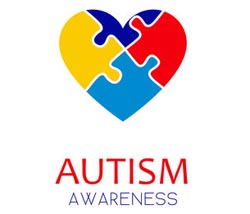April is National Autism Awareness Month and a great time to learn more about the signs and treatment of Autism Spectrum Disorder (ASD).
- Approximately one in 54 children has been diagnosed with autism spectrum disorder (ASD).
- ASD occurs in all racial, ethnic and socioeconomic groups.
- Four times more boys than girls are diagnosed with ASD.
- About one in six children aged 3–17 were diagnosed with a developmental disability, as reported by parents, during a study period of 2009-2017. Diagnoses included autism, attention-deficit/hyperactivity disorder, blindness, cerebral palsy and others.
Autism is a developmental disability that can cause various challenges. People with ASD may communicate, interact, behave and learn in different ways from most people. Additionally, people with ASD require various levels of help in their daily lives.
An ASD diagnosis includes several conditions: autistic disorder, pervasive developmental disorder not otherwise specified (PDD-NOS) and Asperger syndrome.
Socializing and communicating can be problematic for people with ASD. They do not adjust well to changes in daily activities. Additionally, they often have different ways of learning, paying attention or reacting.
Children or adults with ASD might:
- not point at objects to show interest and not look when someone points at them
- have trouble relating to others or not show interest in others
- avoid eye contact and want to be alone
- be unable to understand other people’s feelings or talking about their own feelings
- prefer not to be held or cuddled, or might cuddle only when they want to
- appear to be unaware when people talk to them, but respond to other sounds
- be interested in people, but not know how to talk, play or relate to them
- repeat words or phrases said to them
- have trouble expressing their needs
- not play “pretend” games
- repeat actions over and over
- have unusual reactions to the way things smell, taste, look, feel or sound
- lose skills they once had
Diagnosis
There is no test for ASD so diagnosis is difficult. Doctors diagnose it by observing behavior and development. It can sometimes be diagnosed earlier, but by age 2, a diagnosis by an experienced professional can be considered reliable. Some children do not receive a final diagnosis until much older. Sadly, this delay prevents them from getting the early help they need.
Treatment and Intervention
There is no cure for ASD. However, there are interventions that may reduce symptoms, improve cognitive ability and daily living skills and maximize the child’s ability to function and participate in the community.
Types of treatments include applied behavior analysis, social skills training, occupational therapy, physical therapy, sensory integration therapy and the use of assistive technology.
Because everyone is different, it can take time to find the best treatment for each child. However, the child’s pediatrician can help parents through the process. In addition, there are groups of parents whose children have ASD that are willing to share knowledge and experience.
There are also Facebook groups, playgroups, sports for special needs children and more. An online search will yield a list of resources and activities available in North Texas.


